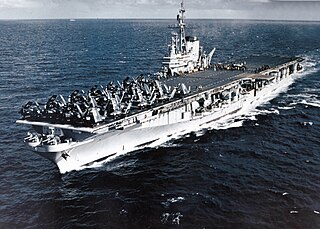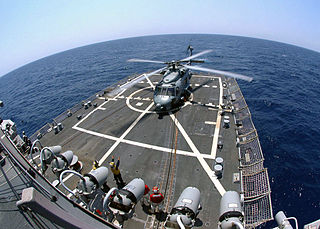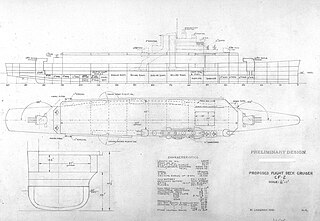This article has multiple issues. Please help improve it or discuss these issues on the talk page . (Learn how and when to remove these template messages)
|
Peter Waldner is the creator of the syndicated comic strip Flight Deck.
This article has multiple issues. Please help improve it or discuss these issues on the talk page . (Learn how and when to remove these template messages)
|
Peter Waldner is the creator of the syndicated comic strip Flight Deck.

An aircraft carrier is a warship that serves as a seagoing airbase, equipped with a full-length flight deck and facilities for carrying, arming, deploying, and recovering aircraft. Typically, it is the capital ship of a fleet, as it allows a naval force to project air power worldwide without depending on local bases for staging aircraft operations. Carriers have evolved since their inception in the early twentieth century from wooden vessels used to deploy balloons to nuclear-powered warships that carry numerous fighters, strike aircraft, helicopters, and other types of aircraft. While heavier aircraft such as fixed-wing gunships and bombers have been launched from aircraft carriers, these aircraft have not successfully landed on a carrier. By its diplomatic and tactical power, its mobility, its autonomy and the variety of its means, the aircraft carrier is often the centerpiece of modern combat fleets. Tactically or even strategically, it replaced the battleship in the role of flagship of a fleet. One of its great advantages is that, by sailing in international waters, it does not interfere with any territorial sovereignty and thus obviates the need for overflight authorizations from third-party countries, reduces the times and transit distances of aircraft and therefore significantly increase the time of availability on the combat zone.

The Boeing 747 is a large, long-range wide-body airliner designed and manufactured by Boeing Commercial Airplanes in the United States. After introducing the 707 in October 1958, Pan Am wanted a jet 2+1⁄2 times its size, to reduce its seat cost by 30% to democratize air travel. In 1965, Joe Sutter left the 737 development program to design the 747, the first twin-aisle airliner. In April 1966, Pan Am ordered 25 Boeing 747-100 aircraft and in late 1966, Pratt & Whitney agreed to develop its JT9D engine, a high-bypass turbofan. On September 30, 1968, the first 747 was rolled out of the custom-built Everett Plant, the world's largest building by volume. The first flight took place on February 9, 1969, and the 747 was certified in December of that year. It entered service with Pan Am on January 22, 1970. The 747 was the first airplane dubbed "Jumbo Jet", the first wide-body airliner.

A flight engineer (FE), also sometimes called an air engineer, is the member of an aircraft's flight crew who monitors and operates its complex aircraft systems. In the early era of aviation, the position was sometimes referred to as the "air mechanic". Flight engineers can still be found on some larger fixed-wing airplanes and helicopters. A similar crew position exists on some spacecraft. In most modern aircraft, their complex systems are both monitored and adjusted by electronic microprocessors and computers, resulting in the elimination of the flight engineer's position.

The flight deck of an aircraft carrier is the surface from which its aircraft take off and land, essentially a miniature airfield at sea. On smaller naval ships which do not have aviation as a primary mission, the landing area for helicopters and other VTOL aircraft is also referred to as the flight deck. The official U.S. Navy term for these vessels is "air-capable ships".

The Midway-class was a class of three United States Navy aircraft carriers. The lead ship, USS Midway, was commissioned in September 1945 and decommissioned in 1992. USS Franklin D. Roosevelt was commissioned in October 1945, and taken out of service in 1977. USS Coral Sea was commissioned in April 1947, and decommissioned in 1990.

The Forrestal-class aircraft carriers were four aircraft carriers designed and built for the United States Navy in the 1950s. The class ship was named for James Forrestal, the first United States Secretary of Defense. It was the first class of supercarriers, combining high tonnage, deck-edge elevators and an angled deck. The first ship was commissioned in 1955, the last decommissioned in 1998.

HMS Furious was a modified Courageous-class battlecruiser built for the Royal Navy (RN) during the First World War. Designed to support the Baltic Project championed by the First Sea Lord, Lord Fisher, the ship was very lightly armoured and designed with a main battery of only two 18-inch (460 mm) guns. Furious was modified as an aircraft carrier while under construction. Her forward turret was removed and a flight deck was added in its place, such that aircraft had to manoeuvre around the superstructure to land. Later in the war, the ship had her rear turret removed and a second flight deck installed aft of the superstructure, but this was less than satisfactory due to air turbulence. Furious was briefly laid up after the war before she was reconstructed with a full-length flight deck in the early 1920s.

HMS Argus was a British aircraft carrier that served in the Royal Navy from 1918 to 1944. She was converted from an ocean liner that was under construction when the First World War began and became the first example of the standard pattern of aircraft carrier, with a full-length flight deck that allowed wheeled aircraft to take off and land. After commissioning, the ship was involved for several years in the development of the optimum design for other aircraft carriers. Argus also evaluated various types of arresting gear, general procedures needed to operate a number of aircraft in concert and fleet tactics. The ship was too top-heavy as originally built and had to be modified to improve her stability in the mid-1920s. She spent one brief deployment on the China Station in the late 1920s before being placed in reserve for budgetary reasons.

Naval aviation is the application of military air power by navies, whether from warships that embark aircraft, or land bases.
Taihō was an aircraft carrier of the Imperial Japanese Navy during World War II. Possessing heavy belt armor and featuring an armored flight deck, she represented a major departure from prior Japanese aircraft carrier design and was expected to not only survive multiple bomb, torpedo, or shell hits, but also continue fighting effectively afterwards.

HMS Eagle was an early aircraft carrier of the Royal Navy. Ordered by Chile during the South American dreadnought race as the Almirante Latorre-class battleship Almirante Cochrane, she was laid down before World War I. In early 1918 she was purchased by Britain for conversion to an aircraft carrier; this work was finished in 1924. Her completion was delayed by labour troubles and the possibility that she might be repurchased by Chile for reconversion into a battleship, as well as the need for comparative trials to determine the optimum layout for aircraft carriers. The ship was initially assigned to the Mediterranean Fleet and then later to the China Station, spending very little time in home waters other than for periodic refits.

Fantasy Flight Games (FFG) is a game company based in Roseville, Minnesota, United States, that creates and publishes role-playing, board, and card games. As of 2014, it is a subsidiary of Asmodée Éditions.

Flight Deck is a steel inverted roller coaster located at Canada's Wonderland in Vaughan, Ontario, Canada. It originally opened in 1995 under the name Top Gun until it was renamed in 2008 to Flight Deck, after Paramount Parks sold Wonderland to Cedar Fair which necessitated the gradual removal of all Paramount names and trademarks from the theme park.

HMS Campania was a seaplane tender and aircraft carrier, converted from an elderly ocean liner by the Royal Navy early in the First World War. After her conversion was completed in mid-1915 the ship spent her time conducting trials and exercises with the Grand Fleet. These revealed the need for a longer flight deck to allow larger aircraft to take off, and she was modified accordingly. Campania missed the Battle of Jutland in May 1916, but made a number of patrols with elements of the Grand Fleet. She never saw combat and was soon relegated to a training role because of her elderly machinery. In November 1918 Campania was anchored with the capital ships of the Grand Fleet when a sudden storm caused her anchor to drag. With no second anchor being laid, she hit several of the ships and the collisions punctured her hull; she slowly sank, with no loss of life.

A helicopter deck is a helicopter pad on the deck of a ship, usually located on the stern and always clear of obstacles that would prove hazardous to a helicopter landing. In the United States Navy, it is commonly and properly referred to as the flight deck.

Modern United States Navy aircraft carrier air operations include the operation of fixed-wing and rotary aircraft on and around an aircraft carrier for performance of combat or noncombat missions. The flight operations are highly evolved, based on experiences dating back to 1922 with USS Langley.

The flight-deck cruiser was a proposed type of aircraft cruiser,, designed by the United States Navy during the period between World War I and World War II. Several designs were proposed for the type, but none was approved for construction. The final design was developed just before World War II, and the entry of the United States into the war saw the project come to an end.

The Essex class was a class of aircraft carriers of the United States Navy. The 20th century's most numerous class of capital ship, the class consisted of 24 vessels, which came in "short-hull" and "long-hull" versions. Thirty-two ships were ordered, but as World War II wound down, six were canceled before construction, and two were canceled after construction had begun. Fourteen ships of the class engaged in combat operations during World War II. No Essex-class ships were lost to enemy action even though several sustained crippling damage. The Essex-class carriers were the backbone of the U.S. Navy's combat strength during World War II from mid-1943 on, and, along with the three Midway-class carriers added just after the war, continued to be the heart of U.S. naval strength until the supercarriers came into the fleet in numbers during the 1960s and 1970s. They had considerable growth potential, with numerous members of the class rebuilt to handle the heavier and faster aircraft of the early jet age, and some of these would serve until well after the end of the Vietnam War.

KeyForge is a card game created by Richard Garfield and published by Fantasy Flight Games in 2018.
The Type 076 landing helicopter dock is a class of planned Chinese amphibious assault ship. Compared to the Type 075, the Type 076 is expected to have an electromagnetic aircraft catapult and arresting gear for operating fixed-wing aircraft, likely unmanned combat aerial vehicles (UCAV).